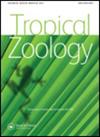Ethnozoological uses of wild animals among the Iraqw in Northern Tanzania
IF 0.4
4区 生物学
Q4 ZOOLOGY
引用次数: 0
Abstract
Historically, humans have developed knowledge of how to exploit and use wildlife species for food, clothing, traditional healing, and other purposes. This study aimed to determine the scale and scope of the ethnozoological uses of wild animals in the Iraqw community, in northern Tanzania. The study used semi-structured face-to-face questionnaire interviews with 45 key respondents in Endagaw, Mewadan, and Ng’wandakw villages in Mbulu District, to acquire the required data. The results found that 28 wild animal species including mammals (13 species), birds (12), insects (1), fish (1), and reptiles (1) were used by Iraqw for different purposes. Most species (n=23) were used mainly for food, namely helmeted guinea fowl (Numida meleagris), African savanna hare (Lemus microtis) and Hildebrandt’s francolin (Francolinus hildebrandti), while other wild animals were used for medicine, traditional beliefs, and rituals. This study provides information on the historical human-nature relationships and a baseline for developing future conservation efforts in the region to protect wild fauna. We recommend similar studies on other traditions and/or modern usages of wildlife to improve protection worldwide and that actions be taken to heighten community awareness of ethnozoological uses of faunal resources to ensure retention of this knowledge for future generations.坦桑尼亚北部伊拉克野生动物的民族动物学用途
从历史上看,人类已经掌握了如何开发和利用野生动物物种作为食物、衣服、传统疗法和其他目的的知识。本研究旨在确定坦桑尼亚北部伊拉克社区野生动物民族动物学利用的规模和范围。该研究采用半结构化面对面问卷访谈方式,对Mbulu区的Endagaw、Mewadan和Ng’wandakw村的45名主要受访者进行了访谈,以获取所需数据。结果表明,伊拉克利用了哺乳动物(13种)、鸟类(12种)、昆虫(1种)、鱼类(1种)、爬行动物(1种)等28种野生动物。大多数物种(n=23)主要用于食物,即盔珍珠鸡(Numida meleagris),非洲热带草原野兔(Lemus microtis)和Hildebrandt 's Francolinus hildebrandti),而其他野生动物则用于医学,传统信仰和仪式。这项研究提供了历史上人类与自然关系的信息,并为该地区未来保护野生动物的工作提供了基础。我们建议对野生动物的其他传统和/或现代用途进行类似的研究,以改善世界范围内的保护,并采取行动提高社区对动物资源的民族动物学用途的认识,以确保为子孙后代保留这些知识。
本文章由计算机程序翻译,如有差异,请以英文原文为准。
求助全文
约1分钟内获得全文
求助全文
来源期刊

Tropical Zoology
生物-动物学
CiteScore
2.50
自引率
0.00%
发文量
1
审稿时长
>12 weeks
期刊介绍:
Tropical Zoology is an international zoological journal publishing original papers in the field of systematics, biogeography, phylogeny, ecology and conservation of all terrestrial and aquatic animal Phyla from tropical and subtropical areas.
Only papers with new information, high quality and broad interest are considered. Single species description and checklists are not normally accepted. Review papers are welcome. The journal is owned by the Istituto di Ricerca sugli Ecosistemi Terrestri of the Consiglio Nazionale delle Ricerche, Florence, Italy (CNR-IRET) who performs research into the structure and functioning of aquatic and terrestrial ecosystems, focusing in particular on anthropogenic pressure and global change. The knowledge amassed forms the scientific basis for identifying the most appropriate protective and corrective interventions, and provides support for the bodies entrusted with formulating policies for environmental protection and recovery.
 求助内容:
求助内容: 应助结果提醒方式:
应助结果提醒方式:


